Dheevatsa Mudigere
Beyond the Buzz: A Pragmatic Take on Inference Disaggregation
Jun 05, 2025Abstract:As inference scales to multi-node deployments, disaggregation - splitting inference into distinct phases - offers a promising path to improving the throughput-interactivity Pareto frontier. Despite growing enthusiasm and a surge of open-source efforts, practical deployment of disaggregated serving remains limited due to the complexity of the optimization search space and system-level coordination. In this paper, we present the first systematic study of disaggregated inference at scale, evaluating hundreds of thousands of design points across diverse workloads and hardware configurations. We find that disaggregation is most effective for prefill-heavy traffic patterns and larger models. Our results highlight the critical role of dynamic rate matching and elastic scaling in achieving Pareto-optimal performance. Our findings offer actionable insights for efficient disaggregated deployments to navigate the trade-off between system throughput and interactivity.
Nonuniform-Tensor-Parallelism: Mitigating GPU failure impact for Scaled-up LLM Training
Apr 08, 2025Abstract:LLM training is scaled up to 10Ks of GPUs by a mix of data-(DP) and model-parallel (MP) execution. Critical to achieving efficiency is tensor-parallel (TP; a form of MP) execution within tightly-coupled subsets of GPUs, referred to as a scale-up domain, and the larger the scale-up domain the better the performance. New datacenter architectures are emerging with more GPUs able to be tightly-coupled in a scale-up domain, such as moving from 8 GPUs to 72 GPUs connected via NVLink. Unfortunately, larger scale-up domains increase the blast-radius of failures, with a failure of single GPU potentially impacting TP execution on the full scale-up domain, which can degrade overall LLM training throughput dramatically. With as few as 0.1% of GPUs being in a failed state, a high TP-degree job can experience nearly 10% reduction in LLM training throughput. We propose nonuniform-tensor-parallelism (NTP) to mitigate this amplified impact of GPU failures. In NTP, a DP replica that experiences GPU failures operates at a reduced TP degree, contributing throughput equal to the percentage of still-functional GPUs. We also propose a rack-design with improved electrical and thermal capabilities in order to sustain power-boosting of scale-up domains that have experienced failures; combined with NTP, this can allow the DP replica with the reduced TP degree (i.e., with failed GPUs) to keep up with the others, thereby achieving near-zero throughput loss for large-scale LLM training.
Disaggregated Multi-Tower: Topology-aware Modeling Technique for Efficient Large-Scale Recommendation
Mar 07, 2024



Abstract:We study a mismatch between the deep learning recommendation models' flat architecture, common distributed training paradigm and hierarchical data center topology. To address the associated inefficiencies, we propose Disaggregated Multi-Tower (DMT), a modeling technique that consists of (1) Semantic-preserving Tower Transform (SPTT), a novel training paradigm that decomposes the monolithic global embedding lookup process into disjoint towers to exploit data center locality; (2) Tower Module (TM), a synergistic dense component attached to each tower to reduce model complexity and communication volume through hierarchical feature interaction; and (3) Tower Partitioner (TP), a feature partitioner to systematically create towers with meaningful feature interactions and load balanced assignments to preserve model quality and training throughput via learned embeddings. We show that DMT can achieve up to 1.9x speedup compared to the state-of-the-art baselines without losing accuracy across multiple generations of hardware at large data center scales.
A Distributed Data-Parallel PyTorch Implementation of the Distributed Shampoo Optimizer for Training Neural Networks At-Scale
Sep 12, 2023



Abstract:Shampoo is an online and stochastic optimization algorithm belonging to the AdaGrad family of methods for training neural networks. It constructs a block-diagonal preconditioner where each block consists of a coarse Kronecker product approximation to full-matrix AdaGrad for each parameter of the neural network. In this work, we provide a complete description of the algorithm as well as the performance optimizations that our implementation leverages to train deep networks at-scale in PyTorch. Our implementation enables fast multi-GPU distributed data-parallel training by distributing the memory and computation associated with blocks of each parameter via PyTorch's DTensor data structure and performing an AllGather primitive on the computed search directions at each iteration. This major performance enhancement enables us to achieve at most a 10% performance reduction in per-step wall-clock time compared against standard diagonal-scaling-based adaptive gradient methods. We validate our implementation by performing an ablation study on training ImageNet ResNet50, demonstrating Shampoo's superiority over standard training recipes with minimal hyperparameter tuning.
MTrainS: Improving DLRM training efficiency using heterogeneous memories
Apr 19, 2023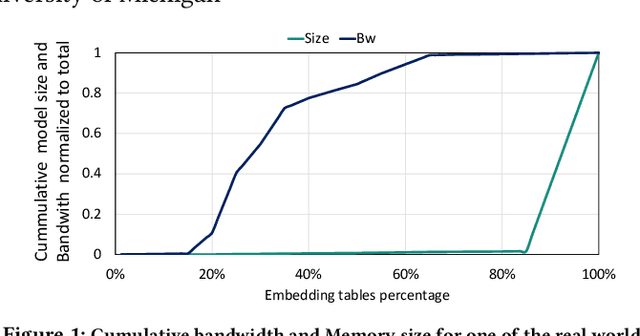
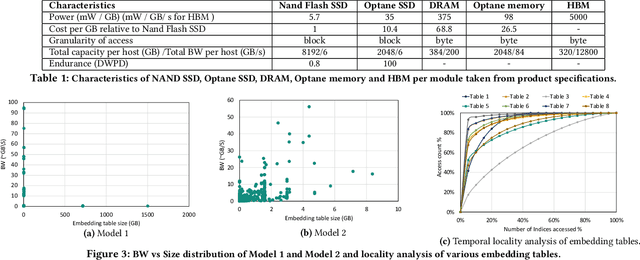
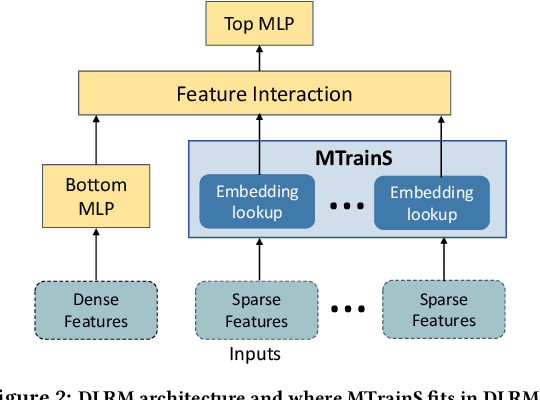
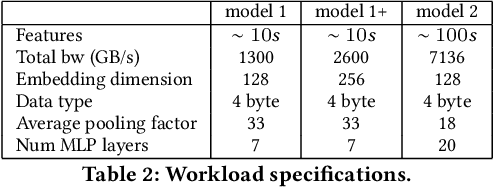
Abstract:Recommendation models are very large, requiring terabytes (TB) of memory during training. In pursuit of better quality, the model size and complexity grow over time, which requires additional training data to avoid overfitting. This model growth demands a large number of resources in data centers. Hence, training efficiency is becoming considerably more important to keep the data center power demand manageable. In Deep Learning Recommendation Models (DLRM), sparse features capturing categorical inputs through embedding tables are the major contributors to model size and require high memory bandwidth. In this paper, we study the bandwidth requirement and locality of embedding tables in real-world deployed models. We observe that the bandwidth requirement is not uniform across different tables and that embedding tables show high temporal locality. We then design MTrainS, which leverages heterogeneous memory, including byte and block addressable Storage Class Memory for DLRM hierarchically. MTrainS allows for higher memory capacity per node and increases training efficiency by lowering the need to scale out to multiple hosts in memory capacity bound use cases. By optimizing the platform memory hierarchy, we reduce the number of nodes for training by 4-8X, saving power and cost of training while meeting our target training performance.
Learning to Collide: Recommendation System Model Compression with Learned Hash Functions
Mar 28, 2022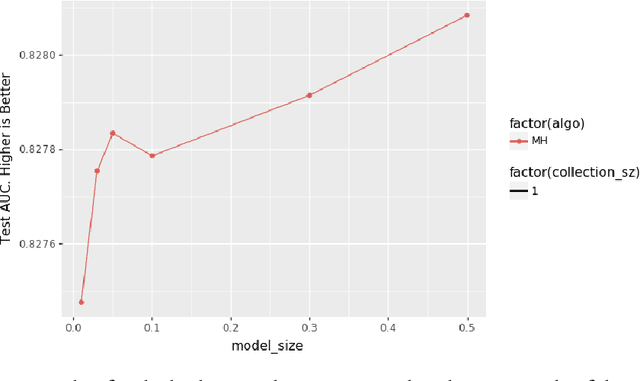

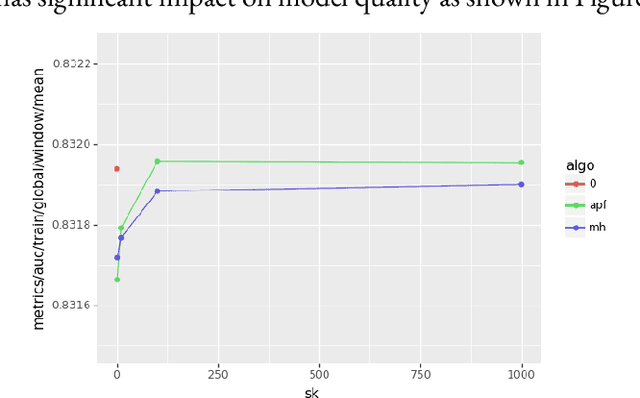
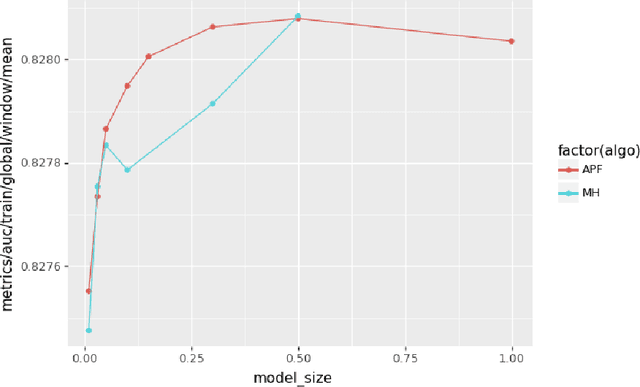
Abstract:A key characteristic of deep recommendation models is the immense memory requirements of their embedding tables. These embedding tables can often reach hundreds of gigabytes which increases hardware requirements and training cost. A common technique to reduce model size is to hash all of the categorical variable identifiers (ids) into a smaller space. This hashing reduces the number of unique representations that must be stored in the embedding table; thus decreasing its size. However, this approach introduces collisions between semantically dissimilar ids that degrade model quality. We introduce an alternative approach, Learned Hash Functions, which instead learns a new mapping function that encourages collisions between semantically similar ids. We derive this learned mapping from historical data and embedding access patterns. We experiment with this technique on a production model and find that a mapping informed by the combination of access frequency and a learned low dimension embedding is the most effective. We demonstrate a small improvement relative to the hashing trick and other collision related compression techniques. This is ongoing work that explores the impact of categorical id collisions on recommendation model quality and how those collisions may be controlled to improve model performance.
DHEN: A Deep and Hierarchical Ensemble Network for Large-Scale Click-Through Rate Prediction
Mar 11, 2022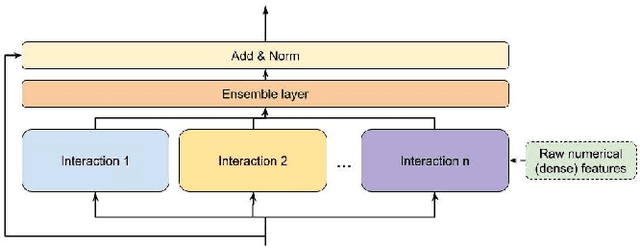

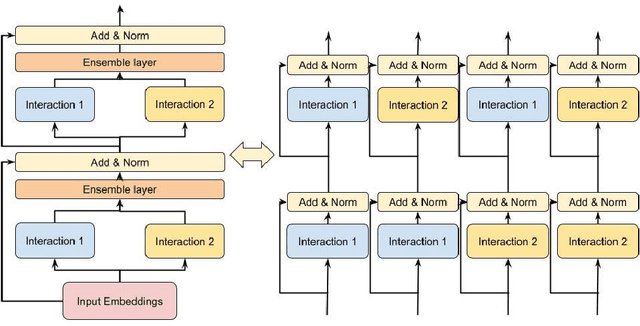

Abstract:Learning feature interactions is important to the model performance of online advertising services. As a result, extensive efforts have been devoted to designing effective architectures to learn feature interactions. However, we observe that the practical performance of those designs can vary from dataset to dataset, even when the order of interactions claimed to be captured is the same. That indicates different designs may have different advantages and the interactions captured by them have non-overlapping information. Motivated by this observation, we propose DHEN - a deep and hierarchical ensemble architecture that can leverage strengths of heterogeneous interaction modules and learn a hierarchy of the interactions under different orders. To overcome the challenge brought by DHEN's deeper and multi-layer structure in training, we propose a novel co-designed training system that can further improve the training efficiency of DHEN. Experiments of DHEN on large-scale dataset from CTR prediction tasks attained 0.27\% improvement on the Normalized Entropy (NE) of prediction and 1.2x better training throughput than state-of-the-art baseline, demonstrating their effectiveness in practice.
Supporting Massive DLRM Inference Through Software Defined Memory
Nov 08, 2021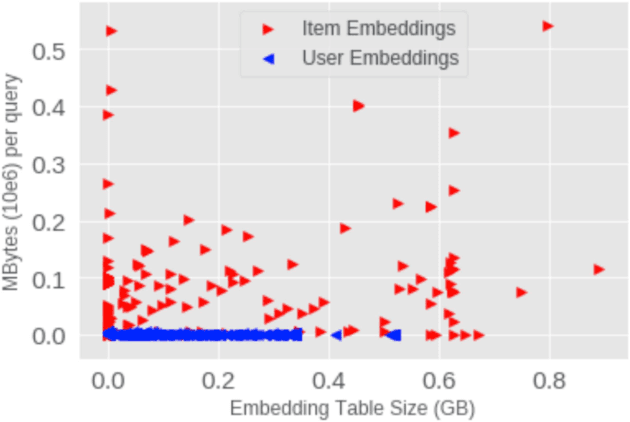

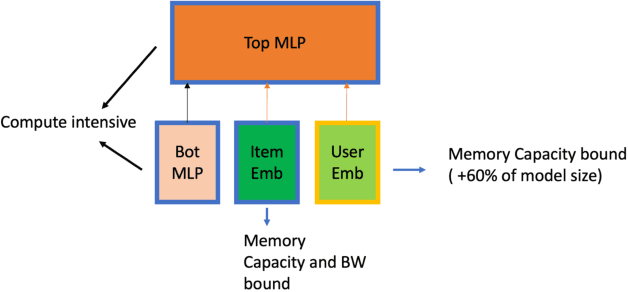
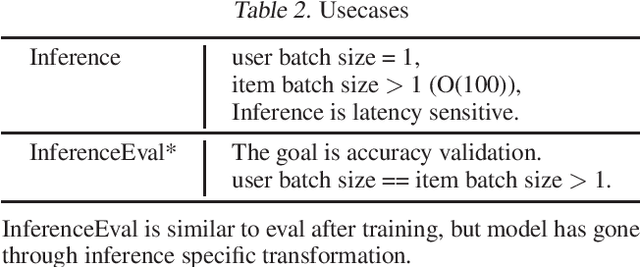
Abstract:Deep Learning Recommendation Models (DLRM) are widespread, account for a considerable data center footprint, and grow by more than 1.5x per year. With model size soon to be in terabytes range, leveraging Storage ClassMemory (SCM) for inference enables lower power consumption and cost. This paper evaluates the major challenges in extending the memory hierarchy to SCM for DLRM, and presents different techniques to improve performance through a Software Defined Memory. We show how underlying technologies such as Nand Flash and 3DXP differentiate, and relate to real world scenarios, enabling from 5% to 29% power savings.
Differentiable NAS Framework and Application to Ads CTR Prediction
Oct 25, 2021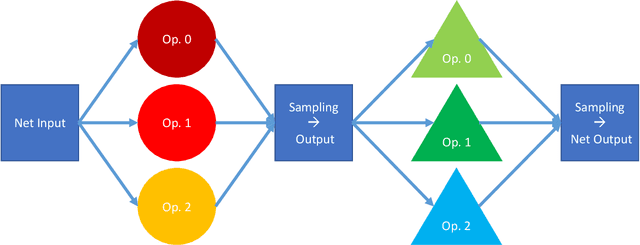
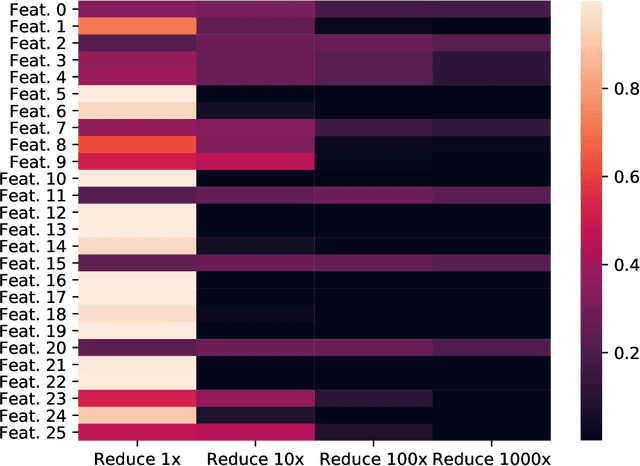
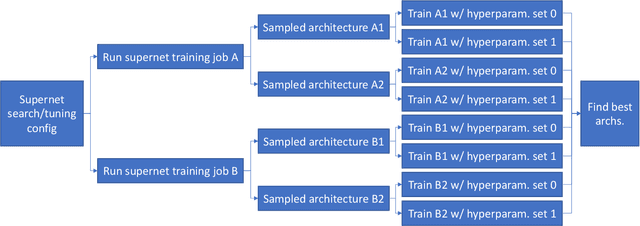

Abstract:Neural architecture search (NAS) methods aim to automatically find the optimal deep neural network (DNN) architecture as measured by a given objective function, typically some combination of task accuracy and inference efficiency. For many areas, such as computer vision and natural language processing, this is a critical, yet still time consuming process. New NAS methods have recently made progress in improving the efficiency of this process. We implement an extensible and modular framework for Differentiable Neural Architecture Search (DNAS) to help solve this problem. We include an overview of the major components of our codebase and how they interact, as well as a section on implementing extensions to it (including a sample), in order to help users adopt our framework for their applications across different categories of deep learning models. To assess the capabilities of our methodology and implementation, we apply DNAS to the problem of ads click-through rate (CTR) prediction, arguably the highest-value and most worked on AI problem at hyperscalers today. We develop and tailor novel search spaces to a Deep Learning Recommendation Model (DLRM) backbone for CTR prediction, and report state-of-the-art results on the Criteo Kaggle CTR prediction dataset.
High-performance, Distributed Training of Large-scale Deep Learning Recommendation Models
Apr 15, 2021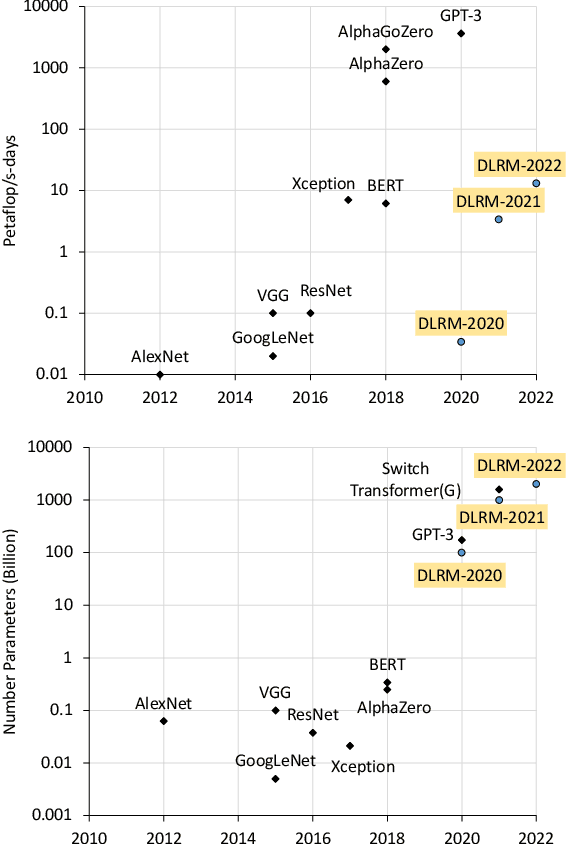
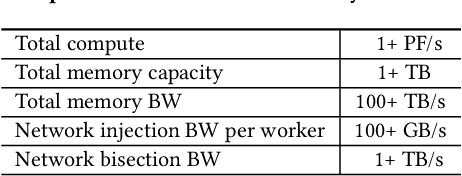
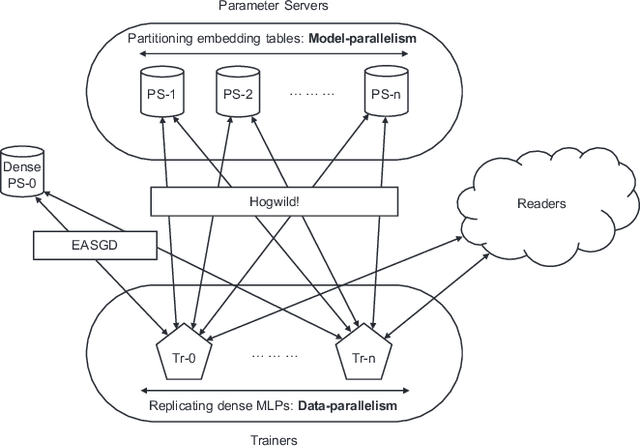
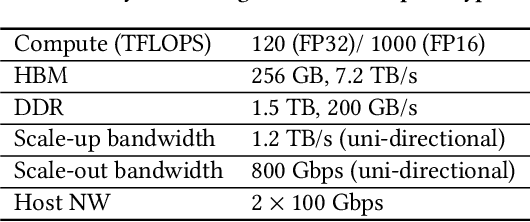
Abstract:Deep learning recommendation models (DLRMs) are used across many business-critical services at Facebook and are the single largest AI application in terms of infrastructure demand in its data-centers. In this paper we discuss the SW/HW co-designed solution for high-performance distributed training of large-scale DLRMs. We introduce a high-performance scalable software stack based on PyTorch and pair it with the new evolution of Zion platform, namely ZionEX. We demonstrate the capability to train very large DLRMs with up to 12 Trillion parameters and show that we can attain 40X speedup in terms of time to solution over previous systems. We achieve this by (i) designing the ZionEX platform with dedicated scale-out network, provisioned with high bandwidth, optimal topology and efficient transport (ii) implementing an optimized PyTorch-based training stack supporting both model and data parallelism (iii) developing sharding algorithms capable of hierarchical partitioning of the embedding tables along row, column dimensions and load balancing them across multiple workers; (iv) adding high-performance core operators while retaining flexibility to support optimizers with fully deterministic updates (v) leveraging reduced precision communications, multi-level memory hierarchy (HBM+DDR+SSD) and pipelining. Furthermore, we develop and briefly comment on distributed data ingestion and other supporting services that are required for the robust and efficient end-to-end training in production environments.
 Add to Chrome
Add to Chrome Add to Firefox
Add to Firefox Add to Edge
Add to Edge